- Offensive Techniques & Strategies
Basketball Basics
The Evolution of the Game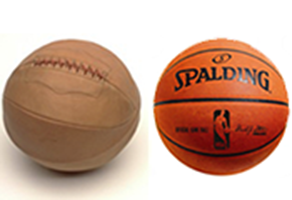
A Chronological Look At The Major Refinements
Dr. Naismith, with all of his imaginative planning, could not have dreamed his "Peach Basket" game would develop into the world's greatest indoor sport. Although the original 13 rules have been expanded to over 100, the spirit and principles of the original rules are still in effect in today. Major rule changes over the years addressed the number of players, the court boundaries, dribbling, and the elimination of the center jump after made baskets. In the mid 1930's inter-sectional competition led to a standardization of rules throughout the country.
Team Size
Originally, there was no set rule on the number of players. The idea was that the game could be played by any number of players. However, that did not work out. After experimenting with teams up to 50 players, early games were primarily played by nine players on each side - the reason being that 18 students showed up for Naismith's class. In 1897 five players became the mandatory team size.
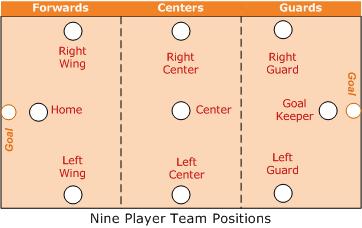
Substitutions
Initially, players were not allowed to re-enter the game. The rule was changed in 1920 to allow a player to re-enter the game one time. In 1934, the rule was expanded to allow players to re-enter the game twice, and, in 1945 the rule was finally changed to permit players to return to the game an unlimited number of times.
Baskets
Originally, the game was played with peach baskets or 18” square boxes hung from the balconies of the running tracks of most indoor facilities. At this time the basket height was established at 10 feet, which still stands today. Obviously, the peach baskets and boxes slowed the game down since the ball had to be retrieved after every goal either by someone on the running track or by ladder. The peach baskets were replaced first by heavy woven wire rims in 1892. Then, a year later, in 1893 cast iron rims were used. Open ended nylon nets were approved for use in 1912. This was a major milestone for basketball since the free falling ball after a made basket dramatically increased tempo and scoring of the game.
Backboards
Wire mesh backboards were introduced in 1895 to prevent spectators in the balconies from interfering with play. Wood replaced the easily dented wire mesh backboards in 1904, and plate glass backboard usage was approved in 1909. Backboards were mounted flat against walls. In 1916 to prevent players from running up the walls for easy lay-ups, a two foot gap was between the backboard and the endline was required. In 1939 this gap was increased from 2 feet to the present 4 feet to allow for more movement underneath the basket.
The Ball

The first basketball games were played with soccer balls. However, they proved to be unsuitable for dribbling and ball handling. The first manufactured basketballs were produced in 1894 by a bicycle manufacturing company. In the late 1890's Spalding took over as the official ball maker. In 1905 the choice of basketballs was left up to the teams. Because of their inability to maintain their shape and their laces, these early brown leather basketballs were hard to dribble. In 1929 basketballs were re-designed for more bounce and with concealed laces which eliminated erratic bounces. The balls were bigger, lighter and easier to handle. In 1942 molded basketballs that maintained a constant shape and size replaced the stitched balls. In 1967 the American Basketball Association (ABA) played with a red, white and blue basketball. Today, the WNBA and FIBA use contrasting panels. The men's ball is 30" in circumference and the smaller women's ball is 29" in circumference.
Scoring
Originally, a successful goal was counted as one point, and one point was also given to a team anytime three consecutive fouls were called on the opponent. Free throws were first introduced in 1894. Both a made field goal and a made free throw were counted as one goal. In 1896, rules were changed to count a made field goal as two points. In 1961 the short lived American Basketball League played with the three point shot. In 1967, the three point shot was introduced into International basketball by FIBA. The three point shot was adopted by the National Basketball Association (NBA) in 1977 and by the National Collegiate Athletic Association (NCAA) in 1980.
Timing
The first games were played in two fifteen minute halves. Shortly later this was increased to two 20-minutes halves. There was no provision for extending the game if the score was tied. In fact, the first game ever played ended in a 2-2 tie. However, once leagues started to be formed, ties needed to be broken. The first tie breakers were "sudden death" with the first team to score a point, either a field goal or free throw, winning the game. Thus, games were decided without one team having a single ball possession. In the 1960's, in order to provide each team with an equal chance, Sudden Death was replaced by overtime periods.
Shot Clock
In 1954 the NBA instituted a 24-second shot clock. This was another milestone for basketball since it eliminated the common stalling tactics that were being deployed, sometimes as early as the third period, by teams' ahead in the game because there was no way for the team behind to catch up other than to foul. The shot clock curtailed the end of game fouling and ensuing parade of free throws which made for a dull game. A 30-second shot clock was deployed internationally by FIBA in 1956, and in 1985, after a USC vs UCLA game and a Missouri vs Kansas game where players actually sat down during the game. The NCAA 45-second shot clock was further reduced to 35 seconds in 1993. Women have used a 30-second shot clock since going to a full court game in 1971.
Fouls
Fouls were assessed for using a fist, traveling and physical contact (holding, pushing, tripping, or striking of an opponent). When a player committed two fouls they were disqualified until a goal was scored. For any flagrant fouls, just as today, players were disqualified for the whole game. When a team committed three consecutive fouls, without the opponent committing a foul, the opponent was awarded a goal - the predecessor to today's bonus rules. In 1911, player fouls for disqualification was increased from two to four, and increased again in 1945 to five fouls. In 1922, traveling or running with the ball was changed to a violation and no longer considered a foul.
Free throws
When free throws were introduced in 1894 the free throw line was established at 21 feet from the basket. Anyone could shoot the free throws. This resulted in teams deploying specialized free throw shooters. A year later, in 1895, the free throw line was moved closer, to a distance of fifteen feet from the basket. In 1924, the free throw rule was amended which required the player who was fouled to shoot the free throws.
Passing
Passing rules have not changed over time. Rules 1 and 2 of the original rules relating to passing the ball are still in effect today.
Dribbling
In the original rules players could not bounce the ball. In 1901, the rule was enacted permitting players to bounce the ball one time. However, players were required to pass the ball and could not shoot after bouncing it. This single dribble amounted to a pass more than a dribble since the ball had to be tossed higher than a player's head and then recovered. Players could use this one bounce tactic numerous times in succession since there was no rule limitation. In 1909, continuous dribbling and shots off dribble were instituted. Being able to shoot off the dribble transformed the dribble from a defensive maneuver to get out of trouble into a potent offensive weapon. Double dribbling was also eliminated at this time. Note: In 1927 there was a period when dribbling was outlawed, but then reinstated two weeks later.
Out of Bounds
In the beginning, boundaries were not defined. In most cases, they were just the walls. It was not until 1904 that boundaries became straight lines. The original rule regarding out of bounds situations turned out to be disastrous. Ball possession was awarded to the first player to touch the ball after it went out of bounds. This led to pushing, shoving, elbowing, desperate dives, and total bedlam. It was even worse when the ball ended up in the balconies, with all players making a mad dash to be first up the stairs which created log jams and fights. Teams resorted to forming wedges to block the opponents from going up the stairs. Teams even tried to bypass the stairs by hoisting players up to the balcony in an effort to be first to touch the ball first.

Basketball at one time was referred to as the "Cage Game" and players' "Cagers." This was a result of wire mesh (chicken wire) or chain-link fencing being hung around the entire court in an effort to make the game go faster by eliminating all the out of bounds delays. However, in reality, it served more as a barrier to protect the players and rowdy spectators from each other, as well as from the objects being thrown onto the court. The wire cage actually resulted in additional rough play with players body checking each other into the wire mesh as in hockey. Players often received cuts, bruises, and even incurred infections from the rusting wire mesh. Although, the use of cages were abandoned by 1933, the term "Cagers" is still used today.
In 1913, the out of bounds rule was changed to the current rule of the team causing or touching the ball last when it goes out of bounds loses possession. This rule change was a major impact in reducing the physical play that was common place in the early games.
Midcourt Line
The midcourt line was established in 1932 to eliminate stalling. Prior to this time, the offensive team had the luxury of the entire court at their disposal of which they took full advantage. This created dull, low scoring games with teams spreading the court and playing keep away rather than trying to score. Adding the midcourt line aided the defensive team by cutting down the area to defend to just half the court. A year later, in 1933, a rule requiring a team to advance the ball past the midcourt line in less than 10 seconds was enacted. FIBA and the NBA modified and reduced the 10 second rule to eight seconds in 2000. College women’s rules do not have a 10 second rule.
Three Second Area
In 1936 the three second area was created to prevent the offensive players from camping around the basket, and to eliminate the ensuing rough play which commonly took place. The three second area was 6 feet wide. Because of its shape, it became know as the "Key" or "Key Hole" In 1951 the three second area was expanded to 12 feet. The NBA and International width is 16 feet.
Comparing the different free throw lanes:
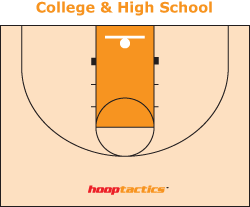



Center Jump
In 1937 a center jump followed each successful basket. Teams with a good jumper had an advantage. Having a jump ball situation after every goal also slowed the game down considerably. Center jump still used today to start game and overtime periods. Alternating possession replaced jump balls in 1981. This was done to eliminate the multiple violations that were occurring on jump balls and officials inconsistency of tossing the ball up.
It should be noted that in the early days, jump balls were extremely physical. Like on the early out of bounds situations, players pushed and shoved in effort to gain possession of the ball. Even, the referee was often caught up in these jump ball skirmishes and sometimes injured.

The more recent rule changes have been instituted in an effort to curtail or neutralize the dominance of the exceptionally gifted, tall player. Namely: Bob Kruland, George Mikan, Bill Russell, Wilt Chamberlain, and Lew Alcindor (Kareem Abdul-Jabbar).
Goal Tending
In 1944 the goal tending rule was adopted making it illegal for a defensive player to touch the ball on its downward flight. This was in reaction to Bob Kurland (the first regular dunker) and George Mikan standing in front of basket and swatting practically every opponent shot attempt.
Offensive Basket Interference
In 1958 offensive basket interference was enacted. Mainly as a result of Bill Russell, who became known as the "Funneler" from using two hands to guide his teammates shots into the basket. Note: In international basketball, once the ball strikes the rim offensive basket interference and goal tending rules do not apply.
Dunking - "Alcindor" Rule
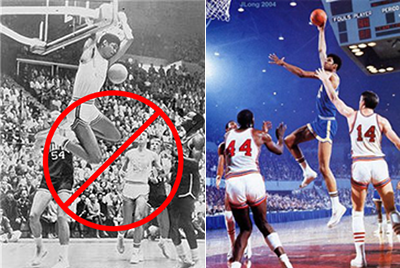
From 1967 to 1977, a no dunking rule was enacted in college basketball. The reasons given were to prevent basket damage and injuries. However, it was specifically aimed at stopping Lew Alcindor. Unable to dunk, Alcindor developed his unstoppable "Sky Hook."
Game Coaching
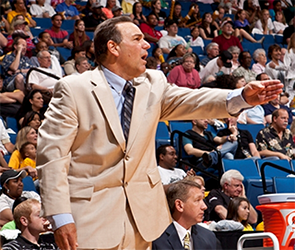
In 1949 coaching during game was officially allowed. Prior to this time, believe it or not, no coaching was allowed during the game or even during a timeout. However, coaching was allowed during half time.
Women's Basketball
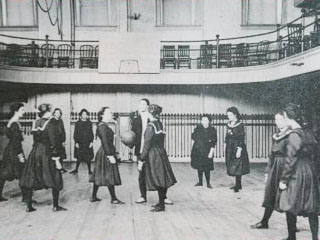
Women's basketball was introduced in 1893 by Sendra Berenson, a gymnastic instructor, at Smith College, Northampton, MA. No male spectators were allowed since it was socially unacceptable at the time. What some say was a result of a misinterpretation of Naismith's court diagram led to three zones sections with two players stationary in each section. In 1938, the three court sections where reduced to two, with two stationary guards, two stationary forwards, and two "rovers that could move around the entire court.
The first intercollegiate women's game was played between Stanford and California in 1896. The first known interscholastic women’s high school game was played in Illinois that same year. In 1971 women were finally allowed to play full court. The first ever women's national championship was conducted by the Amateur Athletic Union (AAU) in 1936. FIBA held the first women’s world championship in 1969 and Louisiana Tech won the first NCAA championship in 1982. In 1995, Oklahoma was the last state to switch from court sections to full court play in high school games.
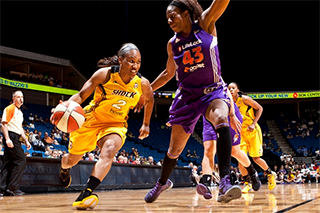
Perhaps the most important event to occur in women's basketball, as well as all women's sports, was the enactment of Title IX in 1972, equalizing men's and women's sports. Today, women's basketball is played with the same enthusiasm and intensity as men’s basketball.
Next, take a look at growing importance of basketball Statistics & Analytics- Click Here
Return to Basketball Basics' Main Menu - Click Here
© 2026 HoopTactics All Rights Reserved.
